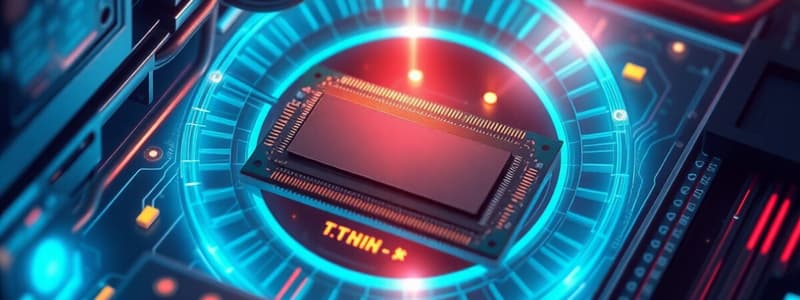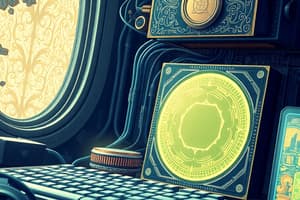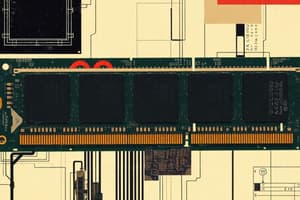Podcast
Questions and Answers
What is the primary purpose of a modem in a computer network?
What is the primary purpose of a modem in a computer network?
- To convert digital signals into analog signals for transmission (correct)
- To store large amounts of data for quick access
- To print documents directly from the computer
- To execute commands given by the user
Which of the following correctly defines the term 'Word size' in computing?
Which of the following correctly defines the term 'Word size' in computing?
- The number of bits processed by the CPU in one operation (correct)
- The maximum length of a text document that can be stored
- The total number of pixels on a computer display
- The amount of data stored in the secondary storage
Identify the application that is typically not part of an office suite.
Identify the application that is typically not part of an office suite.
- Spreadsheet Software
- Presentation Software
- Word Processing Software
- Antivirus Software (correct)
What is the role of cache memory in a CPU?
What is the role of cache memory in a CPU?
Which of the following is true about the binary system?
Which of the following is true about the binary system?
Which protocol is responsible for assigning IP addresses to internet-connected clients?
Which protocol is responsible for assigning IP addresses to internet-connected clients?
What does GUI stand for in the context of computer interfaces?
What does GUI stand for in the context of computer interfaces?
Which of the following best describes OMR technology?
Which of the following best describes OMR technology?
What type of printer is classified as a nonimpact printer?
What type of printer is classified as a nonimpact printer?
Which of the following is NOT an operating system?
Which of the following is NOT an operating system?
Which of the following is not a characteristic of a computer?
Which of the following is not a characteristic of a computer?
The process of transforming input into user-understandable format is associated with which unit?
The process of transforming input into user-understandable format is associated with which unit?
Which of the following is a non-erasable disk used for storing digitized audio?
Which of the following is a non-erasable disk used for storing digitized audio?
Which term refers to the devices that facilitate communication between input/output devices and the computer?
Which term refers to the devices that facilitate communication between input/output devices and the computer?
The smallest unit of data in a computer is defined as which of the following?
The smallest unit of data in a computer is defined as which of the following?
Which type of memory is primarily used for temporary storage during processing?
Which type of memory is primarily used for temporary storage during processing?
Which of the following does not serve as an output device?
Which of the following does not serve as an output device?
Which type of printer prints one line at a time?
Which type of printer prints one line at a time?
Which memory technology is independent of the address bus?
Which memory technology is independent of the address bus?
Which of the following terms refers to computer users who are not professionals?
Which of the following terms refers to computer users who are not professionals?
Flashcards
What is a computer peripheral device?
What is a computer peripheral device?
A computer peripheral device is any external hardware component that connects to a computer.
What is a computer port?
What is a computer port?
A port is a physical interface that enables different devices, such as printers, keyboards, or USB drives, to connect to a computer.
What is ROM?
What is ROM?
ROM stands for Read-Only Memory. It is a type of memory that stores permanent data or instructions that the computer needs to operate, and it cannot be modified by the user.
What is a byte?
What is a byte?
Signup and view all the flashcards
How many bytes are in a megabyte?
How many bytes are in a megabyte?
Signup and view all the flashcards
What are device drivers?
What are device drivers?
Signup and view all the flashcards
What are the two main types of computer memory?
What are the two main types of computer memory?
Signup and view all the flashcards
What is a CD?
What is a CD?
Signup and view all the flashcards
What is outputting?
What is outputting?
Signup and view all the flashcards
What are plotters?
What are plotters?
Signup and view all the flashcards
Binary System
Binary System
Signup and view all the flashcards
Processor Speed
Processor Speed
Signup and view all the flashcards
Soft Copy
Soft Copy
Signup and view all the flashcards
Nonimpact Printer
Nonimpact Printer
Signup and view all the flashcards
OMR (Optical Mark Recognition)
OMR (Optical Mark Recognition)
Signup and view all the flashcards
Booting
Booting
Signup and view all the flashcards
Motherboard
Motherboard
Signup and view all the flashcards
DHCP (Dynamic Host Configuration Protocol)
DHCP (Dynamic Host Configuration Protocol)
Signup and view all the flashcards
TCP/IP (Transmission Control Protocol/Internet Protocol)
TCP/IP (Transmission Control Protocol/Internet Protocol)
Signup and view all the flashcards
Analog Signals
Analog Signals
Signup and view all the flashcards
Study Notes
Computer Hardware and Software
- Peripherals: The CPU is not a peripheral device; peripherals are separate input/output devices.
- Ports: Computer ports allow data transfer between various devices and the computer system.
- ROM: Read-Only Memory (ROM) is non-writable memory.
- Byte: A combination of 8 bits is a byte.
- Megabyte: A megabyte is equal to 1,000,000 bytes.
- Device Drivers: Device drivers facilitate communication between devices and the computer system.
- Memory Types: Primary and secondary memory are the two basic memory types in computers.
- CD: A CD is a non-erasable optical disk for audio storage.
- Outputting: Outputting is the process of producing user-friendly information.
- Plotters: Plotters are used for producing images and drawings.
- Drum Printers: Drum printers are line printers that print one line at a time.
- CRT Monitor: CRT monitors are traditional monitors, typically used with non-portable computers.
- Output Unit Function: The output unit's role is to present processed data, not to feed input to the computer.
- Bit: The smallest unit of data in a computer is a bit.
- Input Unit Function: The input unit receives data, it doesn't transform it into a user-friendly format.
- Data and Information: Data is raw input material; information is processed data.
- Computer Characteristics: A computer's I.Q. isn't a relevant characteristic.
- Main Memory and Address Bus: Main memory size is directly related to the address bus size.
- MAR: MAR stands for Memory Address Register.
- Optical Disks: Optical disks use laser beams for data storage.
- Address Bus Independence: Secondary memory is independent of the address bus.
- Optical Disk Types: A Winchester disk is not an optical disk type.
- Bar code reader: A bar code reader is an input device.
- Primary Storage: Another name for memory is primary storage.
- End-users: Non-computer professionals are considered end-users.
- Powerful Computers: Supercomputers are the most powerful computers.
- Primary Storage Synonyms: Primary storage is also called memory.
- Memory Types: QRAM is not a valid memory type.
- Logic Chips: A logic chip is also called a microprocessor.
- Binary System: Computers represent data using the binary system (0s and 1s).
- Processor Speed: Processor speed for high-end PCs is measured in gigahertz.
- Soft Copy: Soft copy refers to output displayed on a screen.
- Nonimpact Printers: Ink-jet printers are nonimpact printers.
- OMR: "Mark sensing" is another term for Optical Mark Recognition (OMR).
- Office Suite Applications: Antivirus software is not typically part of an office suite.
- File Format: Adobe Acrobat files are in PDF format.
- Booting: The process of loading the operating system is called booting.
- Operating System Examples: MS Access is not an operating system.
- Cache Memory: L1 cache memory is integrated into the CPU.
- Register Length: The length of a register is its word size.
- Web Browser Feature: A web browser seeks a website's address (URL).
- Top-Level Domains: .com is the most commonly used top-level domain.
- Collaborative Software: Groupware is another name for collaborative software.
- Screen Navigation: Scrolling moves page content up or down on the screen.
- Motherboard: The main circuit board in a computer is the motherboard.
- IP Address Assignment: DHCP protocols assign IP addresses to connected devices on the internet.
- Internet Protocol: TCP/IP is the fundamental internet communication protocol.
- Spreadsheet Software: Spreadsheet software is best for personal finance record-keeping.
- Signal Conversion: Computer signals for phone lines must be converted to analog signals.
- Network Layout: Network topology describes the physical layout of a network.
Computer Hardware and Software (True/False)
- CPU Identification: The processor is the CPU. (True)
- Primary Storage Content: Secondary storage holds data not directly used by the processor. (True)
- Homepage Definition: A homepage is a website's main page. (True)
- Powerful PC Type: The most powerful personal computers aren't supercomputers. (False)
- Modem Function: Modems connect computers to phone lines. (True)
- Memory Synonyms: Secondary storage is not memory. (False)
- Information Definition: Processed data is information. (True)
- TCP/IP Nature: TCP/IP is a protocol, not hardware. (False)
- Magnetic Tape Use: Magnetic tape is often used for backups. (True)
- LAN Scope: LANs typically connect devices within a limited area, not two cities. (False)
Computer Hardware and Software (Fill in the Blank)
- Computer Components: The four main hardware components are Input, Output, Storage, and CPU.
- GUI Meaning: GUI stands for Graphical User Interface.
- Binary Unit: A binary value (0 or 1) is a bit.
- Main Circuit Board: The main circuit board inside a system unit is the motherboard.
- SOHO Definition: SOHO stands for Small Office/Home Office.
- Resident Operating System Part: The kernel is the operating system part that remains in memory.
- File Compression Utility: A file compression utility reduces file size.
- Booting Definition: Booting is the process of loading the operating system.
Studying That Suits You
Use AI to generate personalized quizzes and flashcards to suit your learning preferences.




